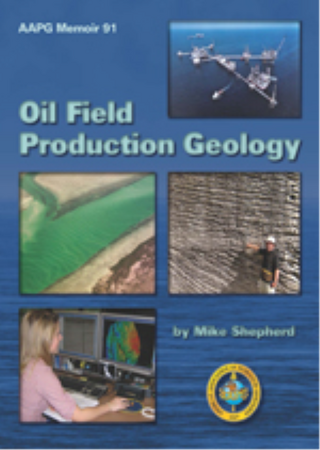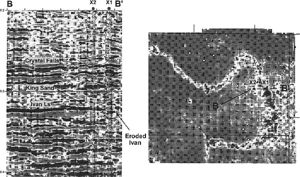Difference between revisions of "Meandering fluvial reservoirs"
(Created page with "'''This page is under construction''' {{publication | image = Oil-field-production-geology.png | series = Memoirs | title = Oil Field Production Geology | part =...") |
|||
| Line 17: | Line 17: | ||
Fluvial reservoirs are difficult for the production geologist to understand, characterize, and model. One major problem involves trying to classify fluvial reservoirs in the subsurface. The system used in this book broadly categorizes fluvial systems into meandering and braided fluvial reservoirs. Although this is a classification used by many production geologists, not all experts are happy with this approach; some believe the classification to be too prescriptive. They consider that only limited inferences can be made from core and log data as to the overall geometry of a fluvial reservoir in the subsurface (e.g., Bridge<ref name=Bridge_2003>Bridge, J. S., 2003, Rivers and flood plains: Forms, processes and sedimentary record: Oxford, Blackwell, 491 p.</ref>). Because of this, some geologists prefer to use a simple nongeneric description by classifying subsurface fluvial geometries as either sheets or ribbons.<ref name=Friendetal_1979>Friend, P. F., M. J. Slater, and R. C. Williams, 1979, [http://jgs.geoscienceworld.org/content/136/1/39.abstract Vertical and lateral building of river sandstone bodies, Ebro Basin, Spain]: Journal of the Geological Society of London, v. 136, p. 39–46.</ref> | Fluvial reservoirs are difficult for the production geologist to understand, characterize, and model. One major problem involves trying to classify fluvial reservoirs in the subsurface. The system used in this book broadly categorizes fluvial systems into meandering and braided fluvial reservoirs. Although this is a classification used by many production geologists, not all experts are happy with this approach; some believe the classification to be too prescriptive. They consider that only limited inferences can be made from core and log data as to the overall geometry of a fluvial reservoir in the subsurface (e.g., Bridge<ref name=Bridge_2003>Bridge, J. S., 2003, Rivers and flood plains: Forms, processes and sedimentary record: Oxford, Blackwell, 491 p.</ref>). Because of this, some geologists prefer to use a simple nongeneric description by classifying subsurface fluvial geometries as either sheets or ribbons.<ref name=Friendetal_1979>Friend, P. F., M. J. Slater, and R. C. Williams, 1979, [http://jgs.geoscienceworld.org/content/136/1/39.abstract Vertical and lateral building of river sandstone bodies, Ebro Basin, Spain]: Journal of the Geological Society of London, v. 136, p. 39–46.</ref> | ||
| − | [[file: | + | [[file:M91Ch11FG70.JPG|thumb|300px|{{figure number|1}}A point bar cut into the underlying Ivan limestone as picked out by varying seismic amplitudes on a horizon display, late Pennsylvanian to Early Permian, Baylor County, Texas (from Burnett<ref name=Burnett_1996>Burnett, M., 1996, [http://archives.datapages.com/data/specpubs/study42/ch05/0062.htm 3-D seismic expression of a shallow fluvial system in west central Texas], in P. Weimer and T. L. Davis, eds.: AAPG Studies in Geology 42 and SEG (Society of Exploration Geophysicists) Geophysical Developments Series 5, p. 45–56.</ref>). Reprinted with permission from the AAPG.]] |
| − | Despite the above difficulties, the production geologist will nevertheless try and find some basis for providing a predictive model for the subsurface geology of a fluvial reservoir. Seismic data can help to determine the planform geometry where it is of sufficient resolution ([[:file: | + | Despite the above difficulties, the production geologist will nevertheless try and find some basis for providing a predictive model for the subsurface geology of a fluvial reservoir. Seismic data can help to determine the planform geometry where it is of sufficient resolution ([[:file:M91Ch11FG70.JPG|Figure 1]]). Fluvial geometries can sometimes be well differentiated on horizon slice amplitude displays (e.g., Brown et al.,<ref name=Brownetal_1981>Brown, A. R., C. G. Dahm, and R. J. Graebner, 1981, A stratigraphic case history using three-dimensional seismic data in the Gulf of Thailand: Geophysical Prospecting, v. 29, no. 3, p. 327–349.</ref> Rijks and Jauffred,<ref name=Rijksandjauffred_1991>Rijks, E. J. K., and J. C. E. M. Jauffred, 1991, Attribute extraction: An important application in any detailed 3D interpretation study: Leading Edge, v. 10, no. 9, p. 11–19.</ref> Noah et al.,<ref name=Noahetal_1992>Noah, J. T., G. S. Hofland, and K. Lemke, 1992, Seismic interpretation of meander channel point-bar deposits using realistic seismic modeling techniques: The Leading Edge, v. 11, p. 13–18.</ref> Carter<ref name=Carter_2003>Carter, D. C., 2003, 3-D seismic geomorphology: [http://archives.datapages.com/data/bulletns/2003/06jun/0909/0909.HTM Insights into fluvial reservoir deposition and performance, Widuri field, Java Sea]: AAPG Bulletin, v. 87, no. 6, p. 909–934.</ref>). |
Meander belt reservoirs show different production behavior characteristics from braided river reservoirs; in the absence of seismic geomorphology evidence, the production geologist should intuitively pick the fluvial geometry type most likely to fit the available data and the reservoir performance. Perhaps because of the uncertainty involved in determining the planform geometry in fluvial reservoirs, the scenario approach (see [[Reservoir uncertainty]]) may be an appropriate tool to help evaluate fluvial reservoirs. | Meander belt reservoirs show different production behavior characteristics from braided river reservoirs; in the absence of seismic geomorphology evidence, the production geologist should intuitively pick the fluvial geometry type most likely to fit the available data and the reservoir performance. Perhaps because of the uncertainty involved in determining the planform geometry in fluvial reservoirs, the scenario approach (see [[Reservoir uncertainty]]) may be an appropriate tool to help evaluate fluvial reservoirs. | ||
Revision as of 15:47, 31 July 2015
This page is under construction
| Oil Field Production Geology | |

| |
| Series | Memoirs |
|---|---|
| Part | The Production Geologist and the Reservoir |
| Chapter | Eolian reservoirs |
| Author | Mike Shepherd |
| Link | Web page |
| PDF file (requires access) | |
| Store | AAPG Store |
Fluvial reservoirs are difficult for the production geologist to understand, characterize, and model. One major problem involves trying to classify fluvial reservoirs in the subsurface. The system used in this book broadly categorizes fluvial systems into meandering and braided fluvial reservoirs. Although this is a classification used by many production geologists, not all experts are happy with this approach; some believe the classification to be too prescriptive. They consider that only limited inferences can be made from core and log data as to the overall geometry of a fluvial reservoir in the subsurface (e.g., Bridge[1]). Because of this, some geologists prefer to use a simple nongeneric description by classifying subsurface fluvial geometries as either sheets or ribbons.[2]

Despite the above difficulties, the production geologist will nevertheless try and find some basis for providing a predictive model for the subsurface geology of a fluvial reservoir. Seismic data can help to determine the planform geometry where it is of sufficient resolution (Figure 1). Fluvial geometries can sometimes be well differentiated on horizon slice amplitude displays (e.g., Brown et al.,[4] Rijks and Jauffred,[5] Noah et al.,[6] Carter[7]).
Meander belt reservoirs show different production behavior characteristics from braided river reservoirs; in the absence of seismic geomorphology evidence, the production geologist should intuitively pick the fluvial geometry type most likely to fit the available data and the reservoir performance. Perhaps because of the uncertainty involved in determining the planform geometry in fluvial reservoirs, the scenario approach (see Reservoir uncertainty) may be an appropriate tool to help evaluate fluvial reservoirs.
See also
- Eolian reservoirs
- Braided fluvial reservoirs
- Deltaic reservoirs
- Deep-water marine reservoirs
- Carbonate reservoirs
References
- ↑ Bridge, J. S., 2003, Rivers and flood plains: Forms, processes and sedimentary record: Oxford, Blackwell, 491 p.
- ↑ Friend, P. F., M. J. Slater, and R. C. Williams, 1979, Vertical and lateral building of river sandstone bodies, Ebro Basin, Spain: Journal of the Geological Society of London, v. 136, p. 39–46.
- ↑ Burnett, M., 1996, 3-D seismic expression of a shallow fluvial system in west central Texas, in P. Weimer and T. L. Davis, eds.: AAPG Studies in Geology 42 and SEG (Society of Exploration Geophysicists) Geophysical Developments Series 5, p. 45–56.
- ↑ Brown, A. R., C. G. Dahm, and R. J. Graebner, 1981, A stratigraphic case history using three-dimensional seismic data in the Gulf of Thailand: Geophysical Prospecting, v. 29, no. 3, p. 327–349.
- ↑ Rijks, E. J. K., and J. C. E. M. Jauffred, 1991, Attribute extraction: An important application in any detailed 3D interpretation study: Leading Edge, v. 10, no. 9, p. 11–19.
- ↑ Noah, J. T., G. S. Hofland, and K. Lemke, 1992, Seismic interpretation of meander channel point-bar deposits using realistic seismic modeling techniques: The Leading Edge, v. 11, p. 13–18.
- ↑ Carter, D. C., 2003, 3-D seismic geomorphology: Insights into fluvial reservoir deposition and performance, Widuri field, Java Sea: AAPG Bulletin, v. 87, no. 6, p. 909–934.